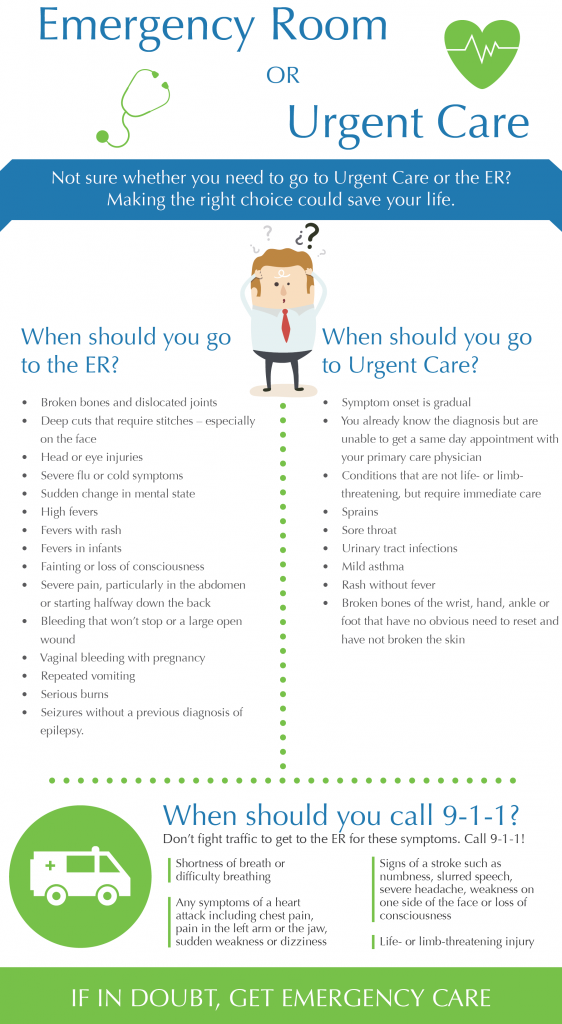See FAQs below:
What Is Considered an Emergency Situation?
According to the American College of Emergency Physicians, you should visit the ER if you have any of the following warning signs:
- Chest pain or pressure
- Uncontrolled bleeding
- Sudden or severe pain
- Coughing or vomiting blood
- Difficulty breathing or shortness of breath
- Sudden dizziness, weakness, or changes in vision
- Severe or persistent vomiting or diarrhea
- Changes in mental status, such as confusion
If you have a chronic condition, discuss in advance with your primary care doctor under what circumstances you should go to the ER.
What is Considered an Urgent Medical Condition?
Urgent medical conditions are ones that are not considered emergencies but still require care within 24 hours. Some examples of such conditions include:
- Accidents and falls
- Sprains and strains
- Moderate back problems
- Breathing difficulties (i.e. mild to moderate asthma)
- Bleeding/cuts — not bleeding a lot but requiring stitches
- Diagnostic services, including X-rays and laboratory tests
- Eye irritation and redness
- Fever or flu
- Vomiting, diarrhea or dehydration
- Severe sore throat or cough
- Minor broken bones and fractures (i.e. fingers, toes)
- Skin rashes and infections
- Urinary tract infections
Urgent Medical Care vs. Emergency Room for Young Children
Head straight to the ER if:
- Your child is less than 2 months old and has a fever. Fever is defined as a temperature 100.4 degrees Fahrenheit (38 degrees Celsius) or higher.
- You suspect your child has a broken bone, particularly if there is visible swelling or unevenness and bumps in the injured area — a sign that the broken bone is misaligned.
- Your child hits his head and appears to pass out or lose consciousness for a few seconds
- Your child has had a seizure
- Your child has signs of dehydration, such as very dry lips and mouth, absence of
urination for more than 12 hours, lethargy and confusion - Your child has heavy, fast breathing, is gasping for air or manages to utter only two
or three words before taking a breath. - Gaping cuts on the face, especially in younger children who need sedation or
behavioral support while the laceration is being repaired.
Consider Urgent Care when you can’t see your pediatrician within a day or two and if:
- Your child has fever accompanied by cold symptoms and you suspect it may be the flu.
- You suspect your child may have an ear infection; symptoms include drainage from the ear, ear ache and pulling on the ears.
- Your child has a sore throat with or without white patches on the tonsils, a possible sign of strep infection.
- You suspect your child may have pink eye, also known as infectious conjunctivitis, symptoms of which include red, inflamed eyes with or without discharge.
- Your child has had a few episodes of vomiting or diarrhea (without blood in the stool) but has no belly pain or signs of dehydration.
Dr. Therese Canares, an emergency physician at Johns Hopkins Children’s Center, recommends, “As a rule, if your child is able to walk, talk, interact and play, chances are whatever she or he has is not an emergency.” Canares also advises calling the Urgent Care clinic ahead of time to ensure they treat infants — many have age limits — and describing your child’s symptoms. “Ask them if based on the age and symptoms, they are comfortable evaluating your child,” Canares says. “And do ask to speak with a clinician, rather than the receptionist. The last thing you want is to show up at the clinic with a sick kid only to be told you should make your way to the ER instead.”
The most important thing to keep in mind when deciding between Urgent Care and Emergency Room treatment is that if you are in doubt, get emergency care.
